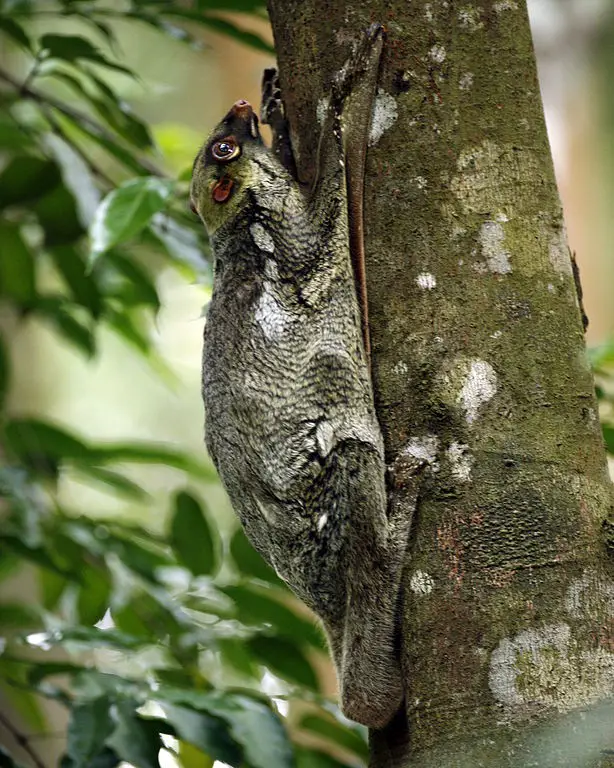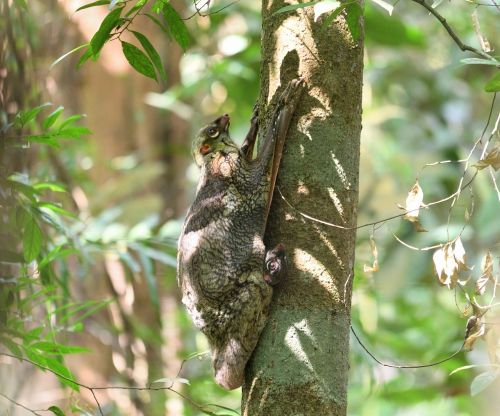It is fun to learn about unique animals. Sunda Colugo famously known as the Flying Lemur is a unique animal that is well known for its gliding capabilities. We have gathered a complete set of Sunda Colugo Facts that will provide you with all the Sunda Colugo Information that you need to know about it. Learn all the facts about Sunda Colugo, its appearance, scientific name & classification, do they fly, lifespan, diet, habitat, food chain, lifecycle, babies, predators, adaptations, endangerment, and other interesting Sunda Colugo Facts.
Sunda Colugo Facts
What Is Sunda Colugo Lemur – Sunda Colugo Flying Lemur
- The Sunda Colugo lemur (also known as Sunda flying lemur) is a Colugo species.
- It is also known as Malayan colugo or Malayan flying lemur.
- Colugo means arboreal gliding mammal, which is a small group having only two species; the Sunda flying lemur and the Philippine flying lemur.
- The Sunda flying lemur is a small furry creature, which is neither truly a lemur nor actually can fly.
- It is a gliding mammal, which is strictly arboreal and rarely goes to the ground.
- It is found all over Southeast Asia; mainly in Malaysia, Singapore, Indonesia, and Thailand.

Sunda Colugo Appearance
- Sunda Colugo is a small animal of up to 1.08 to 1.37 feet (33 to 42 cm) in length.
- Their body weight ranges from 2 to 4.5 pounds (0.9 to 2 kg).
- It has a small head, two large protruding eyes, small ears, and a wide brow.
- Its snout has a blunt shape with no obvious whiskers.
- Sunda Colugos have mottled and dense fur of white, black, grey, or red color at the dorsal or back side of their body while pale at the ventral side.
- Their bold patches of fur resemble lichen on the trees and provide them camouflage.
- They have a special skinny membrane known as patagium, which allows them to glide.
- The patagium is a completely furred membrane spreading with limbs from the neck to toes, fingers, and tail.
- During gliding, an extensor muscle in the flank membrane causes the extension of the patagium to about 2.3 feet (70 cm).
- Sunda Colugos have 4 limbs of equal size.
- They have webbed feet the soles of which form sucking discs during climbing and provide a stronger grip.
- They have flattened digits and curled claws.
- The teeth of Sunda Colugo are carnivore-like and 34 in number.
- The shape of the bottom incisors is comb-like, which might be used for grooming or straining.
- Every incisor has about 20 prongs (projecting points).
- There are no teeth in the front region of the upper jaw, and the upper incisors are located at the jaw sides.
- Their canine teeth are similar to the premolar teeth of other mammals.
Sunda Colugo Scientific Name
- The scientific name of Sunda Colugo is “Galeopterus variegatus”.
Sunda Colugo Taxonomy
- The following is the taxonomy or scientific classification of the Sunda Colugo:
| Kingdom | Animalia |
| Phylum | Chordata |
| Subphylum | Vertebrata |
| Class | Mammalia |
| Order | Dermoptera |
| Family | Cynocephalidae |
| Genus | Galeopterus |
| Species | Galeopterus variegatus |
Do Colugos Fly – Sunda Colugo Flying
- No, Colugos can not fly technically.
- A Sunda Colugo or Sunda flying lemur is an excellent glider and can glide for an average distance of about 330 feet.
- The recorded longest gliding of Sunda Colugo was 446 feet.
- When they spread their limbs out, the patagium catches air and allows them to glide long distances without much loss in altitude.
- The patagium also helps them to move easily between treetops.
Sunda Colugo Lifespan
- Very little is known about the lifespan of Sunda Colugo.
- The oldest known individual lived for 17.5 years in captivity.
- Their lifespan in the wild is unknown.
What Do Sunda Colugo Eat – Sunda Colugo Diet – Sunda Colugo Food
- Sunda Colugo is strictly an herbivore in nature.
- The soft parts of plants are their diet such as; young leaves, buds, flowers, fruits, nectar, and sap.
- They might be used their unusual comb-shaped lower incisors to extract and scrape up sap from trees and strain flowers and fruits.
Where Does The Sunda Colugo Live – Sunda Colugo Habitat
- The geographic range of the Sunda Colugos is in Southeast Asia, where they are endemic to Indochina and Sundaland.
- Sundaland is a region that refers to the Malaya Peninsula and the surrounding islands.
- They are strictly arboreal and mainly inhabit the tropical rainforests.
- They live in the treetops for the rest of their lives and never go to the ground.
- They are adapted well to different types of vegetation such as; disturbed forest edges, primary and secondary forests, lowland and upland forests, mangrove swamps, lowland dipterocarp forests, tree plantations, rubber and coconut plantations, gardens, fruit orchards, and highlands or mountainous areas. However, large populations of Sunda Colugo can not sustain in all of these habitats.
- Not much information is available about the home range of Sunda Colugo.
- Their home ranges are widely overlapped.
- The estimated home range for one Sunda Colugo in the protected forests of Singapore is two hectares.
Sunda Colugo Food Chain
- In the food chain, Sunda Colugos are the Primary Consumers as they eat only producers (plant matter such as leaves, fruits, flowers, nectar, and sap).
- Humans and changeable hawk-eagle eat Sunda Colugos and are the Secondary Consumers in this food chain.
- The dead matter of humans and eagles is then consumed by bacteria and plants.
Sunda Colugo Life Cycle
- The life cycle of Sunda Colugo starts when a baby reaches adulthood.
- A baby Sunda Colugo become an adult at the age of 3 years.
- Not much is known about the courtship and reproductive system of Sunda Colugos.
- They can mate throughout the year.
- Females give birth to a single offspring after a gestation period of about 2 months.
- Twins may be born but are very rare.
- The baby is born underdeveloped and the mothers feed them with her milk for about 6 months.
- It is unknown that Sunda Colugo lives for how much time in the wild.
- In captivity, the oldest known individual lived for about 17.5 years.
Sunda Colugo Baby
- Baby Sunda Colugo was born after a gestation period of about 60 days.
- At the time of birth, it is undeveloped and weighs about 35 g.
- Mothers provide complete parenting care to their babies.
- The baby feeds on the mother’s milk for about 6 months.
- The babies are weak and completely dependent on their mothers until they are weaned.
- To keep the baby protected and warm, a mother folds her patagium and makes a pouch-like sac.
- When a mother is gliding and spreading her patagium, the baby clings to her underside.
- At the age of 3 years, a baby reaches adulthood and becomes independent of the mother.
Sunda Colugo Images – Sunda Colugo Pictures

Sunda Colugo Predators
- There are only a few known predators of the Sunda Colugo.
- The human being is the major one of all the Sunda Colugos’ predators.
- It is hunted for its meat and fur, which is used for making hats and other luxury equipment.
- Changeable Hawk-eagle is also one of the reported predators of Sunda Colugo.
- When threatened, a Sunda Colugo become freeze in its place or climb higher.
- To escape predators, they also glide away up to 100 meters with a little loss in height.
- Their bold patchy fur resembles lichens and provides them excellent camouflage.
Sunda Colugo Adaptations
- Sunda Colugos have several adaptations, which help them to survive in their environment. Such as:
The Patagium
- The most significant adaptation is the presence of patagium. A patagium is a skinny membrane that can spread for about 2.7 feet. A Sunda Colugo used its patagium for gliding. Upon spreading, the patagium catches air and allows them to glide long distances without losing much altitude. Despite gliding, mothers fold their patagium and make a pouch-like sac to keep their babies warm and secure.
Sticky Feet
- A Sunda Colugo has specially adapted sticky feet, just like a small suction pump. Such feet structure allows them to climb easily and also protects them from falling during their landing after glide.
Comb-Shaped Bottom Incisors
- Sunda Colugos have comb-shaped lower incisors. These specially adapted teeth are used for grooming fur, removing parasites, and scraping off insects and sap from trees.
Clinging Of The Baby To The Mother
- Soon after birth, the newborn Sunda Colugos are adapted to tightly cling to their mothers. This adaptation protects the babies and they can move with their mothers even during her gliding between trees.
Bold Patchy Fur
- Sunda Colugo have bold patchy fur that resembles lichens on the trees. It provides them camouflage and hides them from predators.
Sunda Colugo Behavioral Adaptations
- Sunda Colugos are mainly nocturnal creatures.
- They sleep during the daytime in tree holes or the dense foliage of the treetops.
- They use all their four limbs to grasp the underside of tree branches or tree trunks.
- When climbing, they stretch out their two front limbs and then bring up the back limbs. It gives them an awkward hopping-like appearance.
- When feeling any threat, a Sunda Colugo either climbs higher the tree top or becomes motionless at its place.
- They are strictly arboreal and never go to the ground. On the forest floor, they may be quite helpless and vulnerable.
- Sunda colugos are mainly solitary animals and live alone. They sometimes live in small groups with very little connection between the members.
- They may be territorial of foraging and sleeping areas, however, very little is known about their territorial behavior.
- The information about the perception and communication of Sunda Colugos is very limited.
Sunda Colugo Population
- Sunda Colugos are fairly adaptive to many types of habitats, however, their population is continuously decreasing.
- The exact population size of Sunda Colugos is unknown.
- According to the Encyclopedia of Life, the estimated population density of Sunda Colugos is one individual per two hectares in the 2,000 hectares of the protected forests of Singapore. It means their population is about 1,000.
- The IUCN and other reliable sources do not provide any population number of Sunda Colugos.
Is The Sunda Colugo Endangered – Why Is Sunda Colugo Endangered
- Sunda Colugos are endangered due to the loss of habitat from logging and the conversion of forests into farming lands.
- Their local hunting for meat and fur is also a serious threat to their survival.
- Competition with the plantain squirrel in the same habitat is also a reason for their endangeredness.
Sunda Colugo IUCN
- The IUCN Red List classified the Sunda Colugo species like the Least Concerned (LC).
- They are not threatened, near threatened, or vulnerable.
- However, their population is continuously decreasing.
Are Flying Lemurs Marsupials
- Flying lemurs or Colugos are not marsupials (pouched mammals).
- They are placental mammals, however, they raise their babies in a similar way to marsupials.
- Flying lemurs are born underdeveloped (just like marsupials) and weigh only about 1.2 oz (35 g).
- Soon after birth, the newborn clings to the mother’s belly.
- The babies spend the first six months of their lives clinging to their mothers.
- The mother made a warm and protected squasi pouch for her baby by folding her patagium and curling her tail. In this way, a mother flying lemur or Colugo transport and protect her baby.
- The younger flying lemurs also do not mature until the age of 2 to 3 years.
Sunda Colugo Interesting Facts – Sunda Colugo Fun Facts
- Sunda flying lemur (Sunda Colugo) is one of the animals with misleading names. It is not a lemur (it is a colugo) nor a flying animal (it is a gliding animal).
- Sunda Colugo is one of the animal species, which does not do well in captivity. Their breeding and survival in captivity are extremely difficult.
- Previously, a Sunda Colugo was classified as or linked with primates, insectivores, and bats.
- An evolutionary study revealed Sunda Colugos as the closest relatives of primates.
- Sunda colugos are excellent climbers but are vulnerable and helpless on the ground.
- A Sunda Colugo is comfortable enough while hanging underneath a tree branch as it is sitting on the branch.
- A Sunda Colugo can aerodynamically break its glide. To glide and land without any injury, they need a certain distance. Short glides lead to the strongest landing force while a soft landing occurs after long glides.
- Sunda Colugos can glide for a distance of about 330 feet. The recorded longest glide of these little creatures was 446 feet. If we compare it with a football field (which has about 360 feet in length) it is a much greater distance for a small animal.
- As Sunda Colugos adapt well to plantations and other habitats, they destroy fruit crops and are considered pests for fruit plantations.
- As a flower and fruit consumer, a Sunda Colugo may have a role in flower pollination and seed dispersal.











what there blood type sorry if you guy and girl put on there i didn’t see it
You can find information about its blood type here: https://www.ncbi.nlm.nih.gov/gene/103590054